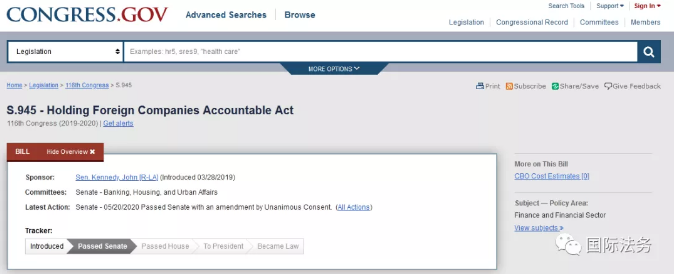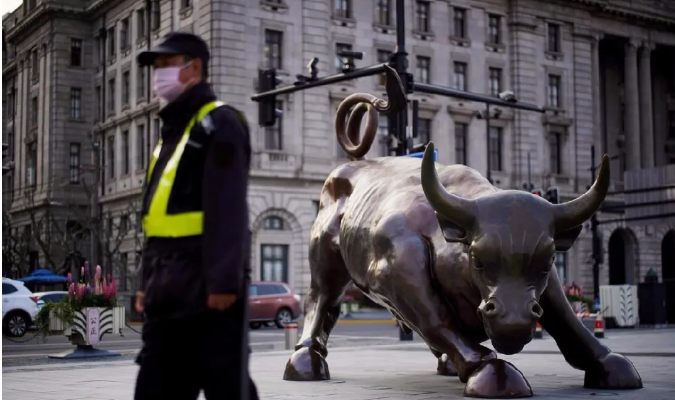美国参议院通过立法“绞杀”中概股
2020-05-26
转载:国际法务
作者:William

美国国会网站截图
上述消息一出,在美上市的中资企业股票逆势下挫 : 尚德机构跌12.18%,寺库跌9.03%,华米科技跌8.65%,阿里巴巴跌2.48%,百度跌2.09%,携程跌2.03%,百济神州跌2.99%。
报道分析,虽然该该法案可能适用于任何寻求进入美国资本的外国公司,但议员们说,加强信息披露要求的举措“主要是针对北京”。该法案参议员获得两党一致通过(注:这种情况在美国不多见),反映出美国议员们对“中国漠视美国财务披露标准”的愤怒。
矛盾与争议的焦点
美国参议院通过的这项《外国公司问责法案》与中国相关法规相冲突。
中国有关法律规定,跨境证券监管事宜应通过中国证监会进行,现场检查应以中国监管机构为主进行,或者依赖中国监管机构的检查结果。而该法案规定,如果某家在美国上市的公司聘用一家不受外国会计公司会计监督委员会(PCAOB)检查的会计师事务所进行审计,那么该法规将要求一家外国公司证明自己“不为外国政府所拥有或操纵”。如果上述监督委员会连续3年无法对该公司的进行检查,那么相关公司发行的证券将被禁止在全美交易所交易。根据美媒报道和所谓指控,争论的焦点是中国长期以来拒绝允许PCAOB审核在纽约证券交易所、那斯达克和其他美国交易所上市的公司审计结果。
PCAOB一直鲜为人知,该机构是2002年为应对安然会计丑闻而成立的核查部门,其目的是防止可能导致股东蒙受损失的欺诈和不当行为。中国和美国上述争论焦点问题上一直存在分歧。据外媒报道,一些白宫人士一直在敦促川普对审计核查采取更强硬的立场。
上周,川普在接受福克斯商业台采访时表示,他正「关注」在纽约证交所和那斯达克挂牌但不遵守美国会计准则的中国公司。不过,他也表示,打击可能会适得其反,并只会导致这些公司转向伦敦或香港的交易所。

中概股排队回归?
据报道,A股已向海外上市企业敞开怀抱,放宽红筹结构企业的上市标准便是一项证明。
今年4月,证监会发布《关于创新试点红筹企业在境内上市相关安排的公告》,为有意愿在境内主板、中小板、创业板和科创板上市的创新试点红筹企业提供路径。其中,就已境外上市的红筹企业标准,放宽至市值200亿元人民币以上,且拥有自主研发、国际领先技术,科技创新能力较强,同行业竞争中处于相对优势地位。同时,创业板试点注册制实施的更加多元的上市条件,也允许符合条件的特殊股权结构企业和红筹企业在创业板上市、为未盈利企业上市预留空间。
除A股外,阿里巴巴的赴港上市,及京东、网易、百度、携程等回港的消息,也引发了市场开始评估中概股回归的可能性。去年,中芯国际结束了在纽约证交所的双重上市,目前仅在香港上市。本月,中芯国际本月公布了在上海科技创新板上市的计划,该事件被认为是有重要方向标意义的有意重大事件。
回归A股的利与弊
申万宏源认为,中概股回归利于扩容国内市场核心资产池,亦有助公司价值发现,利好公司的流动性和估值水平。
日经中文网分析,美国纳斯达克交易所提出更为严格的新上市标准,中国企业在美国上市的难度加大,中国企业正被迫调整融资战略。中国方面已开始鼓励企业在本土上市。但在中国本土上市也有不利的一面。首先是筹措的资金是人民币,不是美元。人民币在换汇和汇款方面有各种制约,特别是在人民币贬值时,各种限制会被强化。由于美元的筹措不稳定,企业的海外业务将抱有风险。2017年至2018年时,海外投资者对新兴企业的投资欲望高,即使是亏损企业也有筹措巨额资金的可能。在中国本土的上市,有可能获得不了像海外一样高的企业评价。
根据美国证监会(SEC)的数据,中国目前有224家市值合计超过1.8万亿美元的在美上市公司。
以下是该法案全文(中文翻译仅供参考,英文原文后附)
第116届国会大会第一届会议
S.945
修改2002年的《萨班斯法案》,要求某些发行人向证券交易委员会披露有关外国司法管辖区的信息,这些司法管辖区阻止了上市公司会计监督委员会(PCAOB)根据该法案或出于其他目的进行的检查。
美国参议院
2019年3月28日
KENNEDY先生(本人和VAN HOLLEN先生)介绍了以下法案;经两次阅读并转交给银行,住房和城市事务委员会
法案
修改2002年《萨班斯-奥克斯利法案》,要求某些发行人向证券交易委员会披露有关外国司法管辖区的信息,这些司法管辖区会阻止上市公司会计监督委员会根据该法案或出于其他目的所进行的检查。
美国国会参议院和众议院通过。
第1节 简短标题
该法案可能被称为“确保外国公司承担责任法案”。
第2节 披露要求
在2002年的《萨班斯-奥克斯利法案》(U.S.C. 1524.15)第104节的末尾增加以下内容:
(i)关于阻止PCAOB 检查的外国管辖权的披露。
(1)定义。在本小节中,
(A)术语“所涉及的发行人”是指根据1934年《证券交易法》第13条或第15(d)条(美国法典第15条第7款,7千8百万;78o(d))提交报告的发行人;和
(B)术语“非检查年度”是指对于所涉及发行人而言,
(i)在此期间,SEC 证券监督委员会针对该发行人在该年度提交的(A)分段中所述的每份报告,根据第(2)(A)款SEC 所确定的该发行人;
(ii)在本小节颁布之日之后开始。
(2)披露给SEC委员会。SEC委员会应-
(A)确定所有所涉及的发行人,这些发行人在提交的第(1)(A)款所述的报告中所包括财务报表的审计报告方面, 所聘请的注册公共会计师,其分支机构或办事处
(i)位于外国司法管辖区,且
(ii)PCAOB无法根据本节要求进行检查;和
(B)要求根据(A)项所确定的发行人,根据SEC委员会第(4)款发布的规则,向委员会提交文件,证明发行人不是由(A)(i)项所述的外国管辖权中的政府实体拥有或控制的。
(3)三年内无法检查的,则其证券应停止交易。
(A)总则。如果委员会确定发行人连续三年没有进行检查,则委员会应禁止该发行人的证券在美国证券交易所进行交易。“
(B)初始禁令的取消。——如果在委员会根据(A)项对有所涉及的发行人施加禁令后,该发行人向委员会证明该发行人已经聘请了在PCAOB注册的且经过检查,并符合SEC委员会满意的公共会计师事务所,SEC委员会应终止该禁令。”
(C)无检查年度的再次发生。——如果委员会在根据(B)或(D)项终止对该发行人的禁令之后,委员会确定该发行人在没有年度检查的情况下,委员会应禁止该发行人的证券在美国证券交易所交易。
(D)后续禁令的取消。——如果自委员会根据(C)项对涉及发行人禁止之日起的5年期限结束后,发行人向SEC 证明,发行人将聘请能够根据本节进行检查的注册公共会计师事务所,SEC应终止该禁令。
(4)实施细则。在本款颁布之日起90天之内,SEC应发布规则,以确定发行人应分别根据第(2)(B)款第(i)和(ii)款进行披露和提交的表格和提交方式’”。
以下为法案的英文全文:
116TH CONGRESS 1ST SESSION
S. 945
To amend the Sarbanes-Oxley Act of 2002 to require certain issuers to disclose to the Securities and Exchange Commission information regard- ing foreign jurisdictions that prevent the Public Company Accounting Oversight Board from performing inspections under that Act, and for other purposes.IN THE SENATE OF THE UNITED STATES
MARCH 28, 2019
Mr. KENNEDY (for himself and Mr. VAN HOLLEN) introduced the following bill; which was read twice and referred to the Committee on Banking, Housing, and Urban Affairs
A BILL
To amend the Sarbanes-Oxley Act of 2002 to require certain issuers to disclose to the Securities and Exchange Com- mission information regarding foreign jurisdictions that prevent the Public Company Accounting Oversight Board from performing inspections under that Act, and for other purposes.
Be it encacted by the Senate and House of Representatives of the United States of America in Congress assembled.
SECTION 1. SHORT TITLE.
This Act may be cited as the ‘‘Holding Foreign Companies Accountable Act’’.
SEC. 2. DISCLOSURE REQUIREMENT.
Section 104 of the Sarbanes-Oxley Act of 2002 (15 U.S.C. 7214) is amended by adding at the end the fol- lowing:
‘‘(i) DISCLOSURE REGARDING FOREIGN JURISDIC- TIONS THAT PREVENT INSPECTIONS.—
‘‘(1) DEFINITIONS.—In this subsection—
‘‘(A) the term ‘covered issuer’ means an issuer that is required to file reports under section 13 or 15(d) of the Securities Exchange Act of 1934 (15 U.S.C. 78m; 78o(d)); and
‘‘(B) the term ‘non-inspection year’ means, with respect to a covered issuer, a year—
‘‘(i) during which the Commission identifies the covered issuer under para- graph (2)(A) with respect to every report described in subparagraph (A) filed by the covered issuer during that year; and
‘‘(ii) that begins after the date of the enactment of this subsection.
‘‘(2) DISCLOSURE TO COMMISSION.—The Commission shall—
‘‘(A) identify each covered issuer that, with respect to the preparation of the audit report on the financial statement of the covered issuer that is included in a report described in paragraph (1)(A) filed by the covered issuer, retains
a registered public accounting firm that has a branch or office that—
‘‘(i) is located in a foreign jurisdic- tion; and
‘‘(ii) the Board is unable to inspect under this section; and
‘‘(B) require each covered issuer identified
under subparagraph (A) to, in accordance with the rules issued by the Commission under para- graph (4), submit to the Commission docu- mentation that establishes that the covered issuer is not owned or controlled by a govern- mental entity in the foreign jurisdiction de- scribed in subparagraph (A)(i).
‘‘(3) TRADING PROHIBITION AFTER 3 YEARS OF NON-INSPECTIONS.—
‘‘(A) IN GENERAL.—If the Commission de- termines that a covered issuer has 3 consecutive non-inspection years, the Commission shall pro- hibit the securities of the covered issuer from being traded on a national securities exchange.
‘‘(B) REMOVAL OF INITIAL PROHIBI- TION.—If, after the Commission imposes a pro- hibition on a covered issuer under subparagraph (A), the covered issuer certifies to the Commission that the covered issuer has re- tained a registered public accounting firm that the Board has inspected under this section to the satisfaction of the Commission, the Com- mission shall end that prohibition.
‘‘(C) RECURRENCE OF NON-INSPECTION YEARS.—If, after the Commission ends a prohi- bition under subparagraph (B) or (D) with re- spect to a covered issuer, the Commission deter- mines that the covered issuer has a non-inspec- tion year, the Commission shall prohibit the se- curities of the covered issuer from being traded on a national securities exchange.
‘‘(D) REMOVAL OF SUBSEQUENT PROHIBI- TION.—If, after the end of the 5-year period be- ginning on the date on which the Commission imposes a prohibition on a covered issuer under subparagraph (C), the covered issuer certifies to the Commission that the covered issuer will re- tain a registered public accounting firm that the Board is able to inspect under this section, the Commission shall end that prohibition.
‘‘(4) RULES.—Not later than 90 days after the date of enactment of this subsection, the Commission shall issue rules that establish the manner and
form in which a covered issuer shall make a disclo- sure and a submission required under clauses (i) and (ii) of paragraph (2)(B), respectively.’’.
参考资料:美国国会官网,华尔街日报,雅虎金融,日经亚洲观察等。
